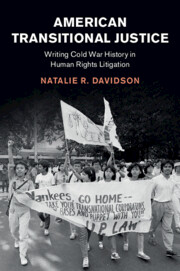Book contents
- American Transitional Justice
- Human Rights in History
- American Transitional Justice
- Copyright page
- Contents
- Figures
- Acknowledgments
- 1 Introduction
- 2 Alien Tort Statute Litigation in Legal Practice and the Legal Imagination
- 3 “Foreign Torture, American Justice”
- 4 Filártiga in Paraguay
- 5 Narrating the Marcos Regime in US Courts
- 6 The Marcos Case and Transitional Justice in the Philippines
- 7 Conclusion
- Book part
- Bibliography
- Index
5 - Narrating the Marcos Regime in US Courts
Published online by Cambridge University Press: 04 June 2020
- American Transitional Justice
- Human Rights in History
- American Transitional Justice
- Copyright page
- Contents
- Figures
- Acknowledgments
- 1 Introduction
- 2 Alien Tort Statute Litigation in Legal Practice and the Legal Imagination
- 3 “Foreign Torture, American Justice”
- 4 Filártiga in Paraguay
- 5 Narrating the Marcos Regime in US Courts
- 6 The Marcos Case and Transitional Justice in the Philippines
- 7 Conclusion
- Book part
- Bibliography
- Index
Summary
This chapter recounts the Marcos case, in which an American jury held Ferdinand Marcos’ estate liable for torture, disappearance, and extrajudicial killing and awarded a class of 10,000 plaintiffs close to two billion dollars in damages. The case has been applauded as a victory of the rule of law over arbitrary power, and a sign of the United States’ commitment to international human rights.This chapter offers a different view of the relationship between abuses under Marcos on the one hand, and law and the United States on the other. In Marcos, the chapter shows, because the lawsuit took the form of a class action against a former head of state, the human rights violations were presented by both plaintiffs and court as systematic policy, in contrast to the US courts’ individualized portrayal of violence in Filártiga. Yet the historical narrative produced by the courts was nonetheless highly distorted, as it whitewashed two key structural foundations of repression under Marcos: US support for the regime, as well as the regime’s extensive use of legal discourse to legitimate and implement repressive policies.
- Type
- Chapter
- Information
- American Transitional JusticeWriting Cold War History in Human Rights Litigation, pp. 106 - 143Publisher: Cambridge University PressPrint publication year: 2020

